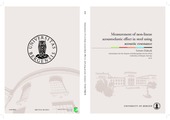| dc.description.abstract | Non-destructive stress measurements of structures are increasingly valued by the industry. Ultrasonic methods have the advantage that acoustic waves propagate with ease through materials, making it possible to probe the interior of structures. Classic elastic models predict constant longitudinal and shear sound velocities in a material. However, by including higher order elastic moduli, the acoustoelastic theory indicate that the sound velocities are affected by the current stress state of the material. Experiments on steel plates have confirmed the dependency of speed of sound with stress in the material. This presents a potential method to estimate pipeline wall stress using ultrasound. Pipeline wall thickness can be measured using resonant ultrasonic signals. The resonant frequencies are linked to the wall thickness via the sound velocity. Thus, equivalently the sound velocities can be estimated when the wall thickness is known. This study has investigated the possibilty of detecting changes in material properties at very high stress in steel utilising an existing acoustic nondestructive testing (NDT) technique called Acoustic Resonance Technology (ART). ART is an ultrasonic technique based on transient acoustic reflections in layer and plates. The technique utilises mainly a pulse-echo method of normally incident longitudinal acoustic signal (pressure waves), recording the longitudinal resonant frequencies across the thickness of a layer. However, it can also be set up to record shear resonant frequencies across the layer thickness by utilising the effect of mode conversion of a slightly off-normal incident pressure wave. Laboratory experiments utilising ART have been used to measure the change in both longitudinal and shear sound velocities across rectangular steel test specimens subjected to uniaxial tensional loads. In addtion the acoustoelastic theory have been implemented and used to simulate the change in sound velocities for some steel types reported in the literature for comparison of experimental results and theory. The theoretical investigation and experimental measurements on steel bars performed in this work have shown that the ART methodology is capable of detecting very small changes, in the order of 0.1%, of the sound velocities for test specimens subjected to high levels of stress. In addition, by comparing longitudinal and shear resonance frequencies, ART is capable of measuring an effect of both longitudinal and shear sound velocity changes independent of the thickness of the specimen. This might be highly valuable for potential in-line inspections along several km of pipelines where the wall thickness may vary on a scale approximately two orders of magnitude larger than the measured variation in stress induced sound velocity change. | en_US |
